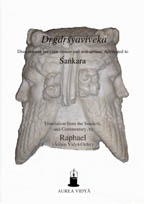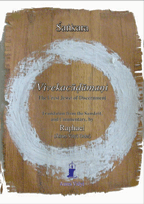|

MANDUKYA UPANISAD
with Gaudapada’s karikas and Shankara’s Commentary
Translation from the Sanskrit and notes by Raphael
The Mandukya Upanishad, with Gaudapada’s karikas and Sakara’s Commentary, is the most significant and profound work, both from a doctrinal and philosophical standpoint, of Advaita Vedanta. It represents, by itself, the foundation of metaphysical realization.
The Upanishad examines the three states of Being (Virat, Hiranyagarbha and Isvara) considering them simply as a chiaroscuro, a phenomenon of the Fourth State or Turiya which is the Absolute Reality. The karikas (commentary in verse) by Gaudapada are divided into four chapters (prakarana) and attempt to give formal expression to a truth experienced by the great asparsin Master; these karikas have been extensively and profoundly commented on by Shankara who takes up the vast hinduist and buddhist philosophical theme. In the Mandukya Upanishad Gaudapada and Shankara present the Asparsa vada, the way of no-support or relation, the metaphysical path of Non-duality, whose sadhana consists purely in what can be termed “awakening” or “reintegration”.
The notes by Raphael, at the end of each chapter, make a remarkable contribution to the metaphysical theme and offer useful clarifications of the Doctrine.
The publication of this most important philosophical text is worthy of note because an integral edition of the work is not easy to find.
CONTENTS: Agama Prakarana (Chapter based on the Scriptures) – Notes – Vaitathya Prakaranaa (about the absolute non-reality of the empirical experience) – Notes – Advaita Prakarana (about Non-duality) – Notes – Alatasanti Prakaranaa (about the extinction of the burning brand) – Notes – Sanskrit text.
approx. 330 pages
FIVE UPANISADS
Isa – Kaivalya – Sarvasara – Amrtabindu – Atharvasira
Translation from the Sanskrit and commentary by Raphael
The Upanishads are an integral part of the Vedas and represent the primeval Tradition; they constitute the Vedanta itself in its essence. The word upanisad indicates that they are intended to destroy ignorance-avidya.
The Upanishads, like other Vedic texts, belong to the Sruti (“audition”) which corresponds to pure and immediate intellectual intuition, the effect of direct inspiration that is applicable only to the domain of metaphysical principles.
Isa is one of the most ancient major Upanishads; Shankara found in it the concise statement of his teachings. Kaivalya teaches how, by means of discrimination (viveka) and detachment (vairagya), we can attain the state of isolation (kaivalya). Sarvasara reflects the fundamental theme of the most ancient Upaniaads. Amrtabindu (or Brahmabindu) contains a pure metaphysical and resolving teaching: how to reach identity with Brahman nirgu…a. Atharvasira presents a dialogue which outlines the precise sequence of a resolving Opus.
Raphael’s commentary to these five Upanishads, closely following the text, clarifies and extends the various points in the light of traditional Teaching, providing the reader with the key to an understanding of their symbolic, figurative and analogical language.
CONTENTS: Isa Upanishad – Kaivalya Upanishad – Sarvasara Upanishad – Amrtabindu Upanishad – Atharvasira Upanishad – Sanskrit text.
approx. 180 pages
Gaudapada
MANDUKYAKARIKA
Beyond the Dance of Siva
Translation from the Sanskrit and commentary by Raphael
This work, traditionally considered Agamasastra, consists of Gaudapada’s commentary in verse (karikas) to the Mandukya Upanishad which, although short, summarizes the whole metaphysical vision of Vedic doctrine.
The first chapter deals with the problem of Reality from the point of view of the Scriptures; the second chapter shows how, with the help of intellectual reason, the objective and subjective spheres of manifestation are not only identical, but also mere, evanescent phenomena. The third chapter proves that no dialectical argumentation is able to deny or contradict the “one-and-without-a-second” Reality. The fourth chapter deals with the solution of the threefold universal phenomenon.
Raphael’s commentary is a conclusive help for the western searcher not familiar with hinduist and buddhist philosophy. Besides, he points out the “operative” aspect included in this text by relating the three states of Being, as described in the Upanishad, both with the cakras and the alchemical process of realization. In order to give a “vision” of the unity underlying Traditional Teaching, he has also included various diagrams relevant to the existential levels and to the constitution of being according to Vedanta, Taoism, Qabbalah, Buddhism, and Plotinus’ Philosophy.
CONTENTS: 1st Chapter, based on the Scriptures – 2nd Chapter, about the absolute non-reality of the empirical experience – 3rd Chapter, about Non-duality – 4th Chapter, about the extinction of the burning brand – Sanskrit text – Glossary.
approx. 190 pages
BHAGAVAD GITA
The Song of the Blessed One
Translation from the Sanskrit and commentary by Raphael
The Bhagavadgita, together with the classical Upanishads and the Brahmasutra, is part of the triple science of Vedanta. Because of the nobility of the subjects it deals with and its majesty it is considered an Upanishad to all effects.
The Gita coordinates and codifies the various yoga paths, but above all it is an initiatory Teaching for the ksatriya, or the way leading to initiation through action. In this perspective it can be of fundamental importance for the West since this is more prone to “action” than to “contemplation”. Raphael indicates in his “Foreword” to the book four basic points which, once they are properly understood, will disclose the Gita elevated doctrinal Teaching, its poetical beauty and its import as a text of initiation.
Raphael’s commentary is particularly useful as he, having adopted the Advaita Vedanta standpoint, reconciles the apparent contradictions (in its universality the Gita offers several possibilities in terms of means and paths) which may surprise the searcher. At the end of each chapter there are some “Considerations” in which Raphael, in addition to proposing a synthesis of the chapter itself, underlines particular points developing them from a psychological, philosophical, initiatory and metaphysical point of view.
CONTENTS: Realization according to Samkhya – Karma yoga – Eulogy of Jnana yoga – The yoga of true renunciation to action – Dhyana yoga – The yoga of knowledge and distinctive science – Brahma yoga – The yoga of regal knowledge – The paths that lead to Divinity – The yoga of the transcendence of the three gunas – The distinction of the triple faith – The yoga of liberation through renunciation – Sanskrit text – Index-Glossary.
approx. 410 pages
DRIGDRISYAVIVEKA **
DISCRIMINATION BETWEEN SELF AND NON-SELF
Translation from the Sanskrit, and Commentary, by Raphael

The Drigdrisyaviveka (Discernment between atman and non-atman) is a rational method of discrimination through which the observer-witness (drig) can be separated from the spectacle (drisya), the atman from the non-atman. Its authorship is doubtful even though some scholars ascribe it to Shankara.
Raphael’s commentary on the fortysix sutra underlines the Advaita Doctrine expounding its basic foundations as they relate to the text. As all methods imply experimentation, Raphael indicates the kind of behaviour which is best suited to practice the method formulated in the Drigdrisyaviveka. This work, considered a true classic of Vedanta, is a necessary introduction to the texts of Vedanta in general and of Advaita Vedanta in particular (non-dualistic Vedanta).
It is worth of note that Raphael in his extensive commentary has compared many passages of the teaching of Plotinus to that of the Vedanta pointing out their similarities and even their identity.
CONTENTS: Subject, object and mental modifications – Consciousness-Cit – Jiva as a reflection of consciousness – Identification – The two powers of maya: projection and veiling – The witness-saksin – The six grades of samadhi – The various types of karma: samcita, agamin, prarabdha – The three theories concerning the jiva – The four vedic mantras – The jiva’s waking and dreaming states – Individual and universal jiva – Sanskrit Text – Bibliography.
approx. 150 pages
Shankara
VIVEKACUDAMANI
THE GREAT JEWEL OF DISCRIMINATION
Translation from the Sanskrit and commentary by Raphael

Shankara (788 - 820) is the codifier of the Advaita Vedanta and the most profound expounder of many texts of the Hindu Tradition, from the Brahmasutra to the Bhagavadgita and the most important Upanishad.
In this work he presents a very stimulating realization dialogue between an advaitin Master and a Disciple. The dialogue, which develops along 580 sutras, is of such audacity and profundity as to shake the very foundations of the human being considered as ego-appearance. Shankara expounds the Doctrine of Advaita Vedanta pointing out the Asparshavada as the method to follow for its realization. Raphael, in its extensive commentary, develops the tenets of Asparshavada clarifying its essential points for the western reader.
«This Asparsha path is for those who, weary of their long pilgrimage, have come to a stop at last, and in the secret of their heart have decided to realize ultimate freedom from every conflict and bondage». If this text is meditated in depth with supraconscious intuition (buddhi), it will lead the disciple gradually to dizzy heights, stimulating and preparing him for the flight towards total transcendence.
CONTENTS: The qualifications of the aspirant – The four cardinal means – The sheaths or superimpositions – The maya-appearance – atman: the witness of the world of appearance – The great bondage: ignorance-avidya – The witness and the five sheaths – Brahman: absolute Reality – That thou art (Tat tvam asi) – The power of discernment – nirvikalpa samadhi – The steps of yoga – Brahman is One-without-a-second – karma – Self-realization – The gratitude of the Disciple towards his Guru – The Awakened – Sanskrit text – Analytical index and glossary.
326 pages
|
|
|